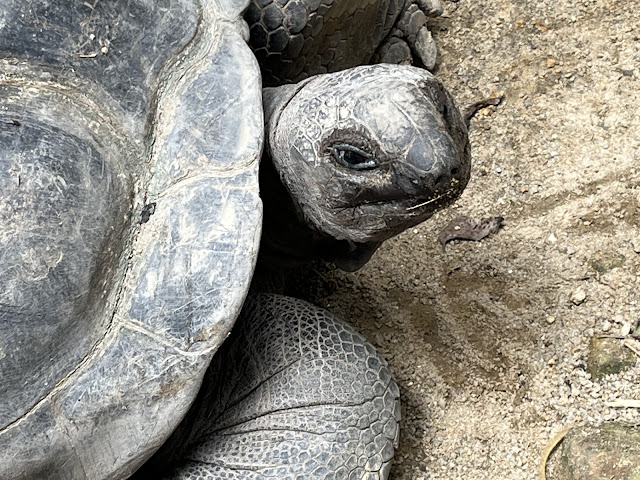March 16
Victoria, Seychelles
"Prince William and Kate honeymooned on our North island," our guide Celice told us. "Of course, a prince would take his bride to paradise!"
The sail in to Victoria was lovely as we skirted a number of little barrier islands and sandbars. As you can see, solar panels and wind turbines have been installed on a harbor islet. Our guide, Celice told us solar provides 17% of the island's electricity requirements.
One of our onboard lecturers showed us how geologically both Madagascar and the Seychelles were once part of the African continent that got left behind as the Indian tectonic place pulled away to the northeast. Seychelles is, in fact, the smallest African nation in terms of both size and population, but they are highest in a measure of income and lifestyle.
The people of Seychelles speak French, English and their own Creole. When the European powers arrived in this part of the world, there were no indigenous residents on the island, but as their 3 official languages suggest, there has been a tug of war over it in the past.
 |
The island is quite mountainous and has a peak that rises to almost 3000 ft.! The original little church was destroyed in the early 20th century when an avalanche of large granite boulders broke free and rolled down on the town. It turned out to be a blessing in disguise. The church originally was situated on the waterfront with the ocean lapping at its steps. The rocks and soil the landslide provided helped the inhabitants build out more reclaimed land and moved the oceanfront several blocks away from the church that was rebuilt on the original site.
It was Sunday when we visited, so all the stalls and shops were closed along Albert Street, but we did get to slip into the back of the large cathedral at the end of the business district. The sanctuary was packed and the congregation was singing a beautiful hymn I didn't recognize. It was sung in French, and all I could translate based on my high school French was "Forgive me, Lord." But the acoustics of the space made the voices soar heavenward as if we were in a giant bathtub! Lovely!
 |
| This is a Coco de Mer nut. What? Were you thinking something else??? |
 |
| Our guide told us the tortoises like to be stroked under their chin on their necks, so when this fellow looked at me expectantly, I gave it a try. He stretched his neck out as long as he could and raised himself from lying on the ground to standing up on all fours so I could more easily stroke his rough skin. |
 |
| Silhouette Island in the distance |
Seychelles is a wonderful destination and I'd love to go back. But there was one thing our guide told us that troubles me. As we were driving along, she pointed out one of their new schools. It was paid for by China.
Almost everywhere in the world we visit, we see Chinese grants, investments and outright building projects including schools, hospitals, ports, etc. Useful things. Things that raise the quality of life of the countries who receive the Chinese government's aid. They seem to be buying friends all around the world with tangible gifts.
There's a lot of discussion about foreign aid right now. I would argue it's important for us to give to countries who need our help. But I'd like to see our aid go in the form of providing fresh water wells, desalination plants where needed. Help with improving agriculture so countries will have more food security.
Much of the world doesn't want us to send them our culture, like the Brits taught them to drive on the left side of the road. The world needs bridges. Better housing. Easy access to fresh water. School buildings.
Essential things.




No comments:
Post a Comment
I'd love to hear from you. Leave a comment and let's chat!